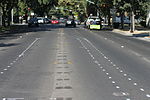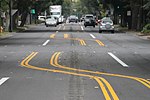Road diet
A road diet (also called a lane reduction, road rechannelization or road conversion) is a technique in transportation planning whereby the number of travel lanes and/or effective width of the road is reduced in order to achieve systemic improvements.
Techniques[edit]

A typical road diet technique is to reduce the number of lanes on a roadway cross-section. One of the most common applications of a road diet is to improve safety or provide space for other modes of travel.[1] For example, a two-way, four lane road might be reduced to one travel lane in each direction.[2] The freed-up space is then used to provide or enhance some of the following features:
- Adding or widening of footpaths / sidewalks
- Adding or widening of boulevards (landscaping strips)
- Adding cycle lanes on one or both sides of the road
- Adding reserved tramtracks, usually in the middle of the road
- Widening remaining traffic lanes (if previously unsafely narrow to allow four lanes)
- Adding a center turn lane / flush traffic median for turning traffic
- Adding a reversible center lane
- Conversion of the rightmost or leftmost travel lane to a breakdown lane (The Lodge Freeway in metro Detroit is an example of this after I-96, the Jeffries Freeway, was built.)
If properly designed, traffic does not divert to other streets after a road diet, because the road previously provided excessive capacity. In other scenarios, reduction of traffic (either local traffic or overall traffic) is intended in the scheme. Road diets are usually successful on roads carrying fewer than 19,000 vehicles per day. Road diets can succeed at volumes up to about 23,000 vehicles per day. However, more extensive reconstruction is needed. Examples include replacing signals with roundabouts, traffic calming on parallel streets to discourage traffic from diverting away from the main road, and other means to keep traffic moving smoothly and uniformly.[citation needed]
Lane diets[edit]
In a lane diet, the width of a lane is decreased to reduce vehicle speeds and yield space for other use.[3] Typically vehicular travel lane widths are narrowed to no more than 10 feet (3.0 m), and left turn (in countries where drivers use the right-hand side of the road) storage lanes to 9 or 10 feet (2.7 or 3.0 m).[citation needed] Resulting space can be applied to pedestrian refuges, medians, sidewalks, shoulders, parking, or bike lanes.[3]
Impacts[edit]
Researchers and the U.S. Department of Transportation (Federal Highway Administration) have found that road diets can be expected to reduce overall crash frequency by 19% to 43%, with the higher crash reductions occurring in small urban areas than in metropolitan areas.[4]
Dan Burden and Peter Lagerwey a 1999 article noted that in two cases, 95% of residents were initially opposed to roadway constriction.[5] Additional studies have shown that road diets often achieve these positive effects without reducing traffic volumes.
A 2004 study by the Federal Highway Administration found that road diets decreased the risk of collisions and serious injury. When average daily traffic exceeds 20,000 vehicles a day, however, this increase in safety comes with the tradeoff of increased congestion and the possibility of diverting traffic to alternate routes.[6]
Implementation examples by country[edit]
United Kingdom[edit]
During the Covid-19 pandemic, London implemented a number of road diets to give more space to active travel modes such as bicycle lanes, on a number of its roads. For example, the formerly three-lane northbound carriageway of Park Lane was reduced to one lane for motor traffic, one bus lane and one segregated cycle way.[7]
United States[edit]
Among American cities, San Francisco has completed the most road diet projects, over 40 since the late 1970s.[8] Valencia Street, which was reduced from four to two travel lanes with a center turn lane and bike lanes added in March 1999, has become a national model for traffic engineers of the common "4-to-3 lane" road diet type.[9]
San Jose, California has implemented several road diets since November 2011, when the City Council unanimously adopted its "Envision 2040" General Plan,[10] which calls for road diets on streets with excess vehicle capacity "to provide wider sidewalks, bicycle lanes, transit amenities, and/or landscaping".[11] Road diets were completed on 3rd, 4th, 10th, and 11th streets in August 2012,[12][13] and on Hedding Street in July 2013.[14]
Constricting traffic arteries has been controversial in Los Angeles, California, where traffic fatalities increased 32% since beginning its Vision Zero road diet plan in 2015.[15]
Palo Alto, California has studied reducing the number of travel lanes to improve safety on some of its busiest streets since adopting a new Comprehensive Plan in 1998. Design plans were made for road diets on Embarcadero Road and Middlefield Road[16] in the early 2000s, but were never brought to the city council for approval. 75-yr-old local resident Ming Yuan Zuo was killed by a pickup truck driver while walking across Embarcadero Road in January 2013.[17] Lane reductions were approved and then implemented on Charleston Road in 2006,[18] Arastradero Road in 2010,[19] and Deer Creek Road in 2011.[20]
In Tampa, Florida, Nebraska Avenue between its intersection with Hillsborough Avenue (US 92-US 41-FL 600) and Adamo Drive was reduced from four to three lanes, complete with bicycle lanes, a left turn lane and embedded bus stops for HART buses. Construction was completed in 2009.[21]
In Rutland, Vermont, the city briefly converted Woodstock Avenue from a four-lane road to a three-lane road with bicycle lanes on each side. However, due mainly to opposition from businesses alongside the road in June 2014, Woodstock Avenue was returned to its previous four-lane configuration.[22]
In Waverly, Iowa the city converted Bremer Avenue from a four-lane road to a three-lane road with a safety buffer on each side. The city faced criticism due to some citizens’ belief the change has caused slower emergency response time.[23]
See also[edit]
- Reversible lane
- Contraflow lane reversal
- 2+1 road
- Street hierarchy
- Tactical urbanism – Low-cost, temporary improvement to a city
- Transit mall – Urban street reserved for public transit, bicycles, and pedestrians
- Freeway removal – Replacement of motorways with pedestrian-friendly and urbanist land uses
- Street reclamation – Changing streets to focus on non-car use
- Unused highway – Roads that were closed or never used
References[edit]
- ^ McGreevy, Patrick (May 27, 2019). "Using California gas tax to reduce traffic lanes? Not how it should be spent, some say". Los Angeles Times. Retrieved May 28, 2019.
- ^ "Road Diet Guide - Car Free America". Car Free America. Retrieved 31 October 2017.
- ^ a b How's That Diet Working: Performance of Virginia Road Diets (PDF) (Report). Virginia Transportation Research Council. April 2020. Retrieved 12 October 2022.
A lane diet is a related term referring to the narrowing rather than removal of travel lanes to accommodate bicycle lanes, turn lanes, parking lanes, or traffic calming elements.
- ^ Turner-Fairbank Highway Research Center (June 2010). "Evaluation of Lane Reduction 'Road Diet' Measures on Crashes". Federal Highway Administration. FHWA-HRT-10-053.
- ^ Burden, Dan & Lagerwey, Peter (March 1999). "Road Diets: Fixing the Big Roads" (PDF). Walkable Communities.
- ^ Turner-Fairbank Highway Research Center (March 2004). "Evaluation of Lane Reduction 'Road Diet' Measures and Their Effects on Crashes and Injuries". Federal Highway Administration. FHWA-HRT-04-082.
- ^ Jones, Harrison (14 May 2020). "Road turns into giant cycle lane to make social distancing easier". Metro. Retrieved 3 May 2021.
- ^ Reisman, Will (24 August 2012). "Road Diets Used as Tool for Reclaiming Neighborhoods in San Francisco". San Francisco Examiner. Retrieved 10 February 2014.
- ^ Roth, Matthew (31 March 2010). "San Francisco Planners Proud of Long List of Road Diets". Streetsblog San Francisco. Retrieved 10 February 2014.
- ^ Seipel, Tracy (31 October 2011). "San Jose's Updated General Plan Emphasizes 'Smart Growth,' Healthier Communities". San Jose Mercury News. Retrieved 10 February 2014.
- ^ Envision San Jose 2040. City of San Jose. November 2011. ch. 6, p. 38. Retrieved 10 February 2014.
- ^ Diaz, Kim (13 August 2012). "New Bike Lanes Introduced to Downtown Streets". SanJose.com. Retrieved 10 February 2014.
- ^ Diaz, Kimberley (29 August 2012). "New Bike Lanes in San Jose". Spartan Daily. Archived from the original on 22 February 2014. Retrieved 10 February 2014.
- ^ Masoner, Richard (19 July 2013). "Hedding Street Green Bike Lane Ribbon Cutting Sunday". Cyclelicious. Retrieved 10 February 2014.
- ^ "More people are dying on L.A.'s streets despite a push to eliminate traffic fatalities". Los Angeles Times. 25 April 2019.
- ^ Dong, Jocelyn (8 December 2004). "Narrowing Middlefield Sparks Wide Outcry". Palo Alto Weekly. Retrieved 10 February 2014.
- ^ "Pedestrian Killed while Crossing Embarcadero Is Identified". Palo Alto Online. 28 January 2013. Retrieved 10 February 2014.
- ^ Trout, Becky (14 May 2008). "Charleston Road Safer, Better after Lane Changes, Council Agrees". Palo Alto Weekly. Retrieved 8 October 2011.
- ^ Transportation Division (14 October 2010). "Community Meeting Notice, Arastradero Road Restriping–Trial Project" (Press release). City of Palo Alto. Retrieved 8 October 2011.
- ^ Sheyner, Gennady (29 July 2011). "Palo Alto Speeds ahead with Traffic-Calming Projects". Palo Alto Weekly. Retrieved 8 October 2011.
- ^ Redesigned Nebraska Avenue Significantly Safer, The Tampa Tribune. Retrieved 2015-06-15.
- ^ Rutland scrapping plans for bike lanes along Woodstock Ave, WCAX. Retrieved 2015-06-15.
- ^ Road Diets lead to big fat safety concerns for emergency responders. https://www.desmoinesregister.com/story/opinion/columnists/iowa-view/2019/02/13/road-diets-lead-safety-concerns-emergency-response-traffic/2862872002/


